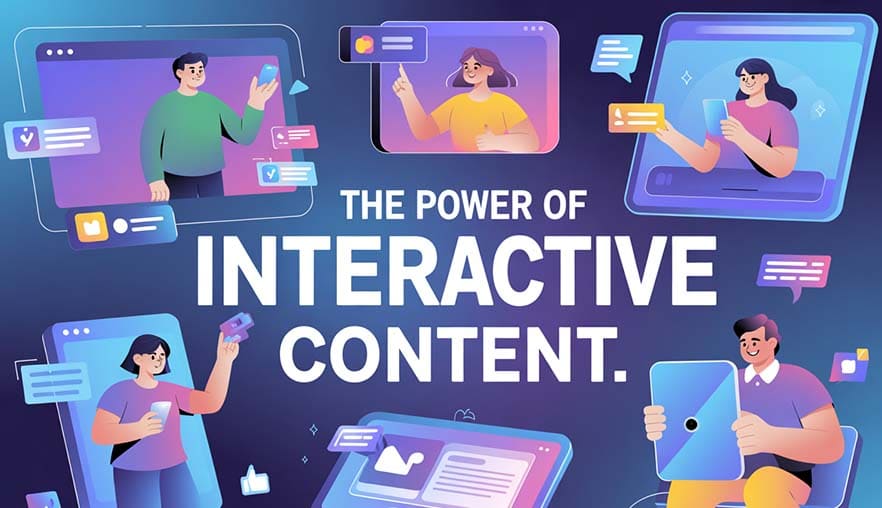In today’s fast-paced digital landscape, consumers are constantly bombarded with information. Traditional, static content like blog posts and simple images often gets lost in the noise. To truly capture your audience’s attention and drive meaningful action, your digital marketing strategy needs to evolve. The answer lies in the dynamic and immersive world of interactive content.
Interactive content flips the traditional marketing script. Instead of your audience passively consuming information, it invites them to participate, click, and engage directly with your brand. This shift from a one-way monologue to a two-way dialogue is not just a trend; it’s the new standard for building deeper connections, gathering valuable data, and supercharging your marketing performance.
What makes interactive content so powerful?
The effectiveness of interactive content is rooted in psychology. By leveraging principles like active learning, gamification, and the human desire for personalization, interactive formats create more memorable and impactful experiences.
1. Increases engagement and reduces bounce rates
Interactive content requires participation, which naturally holds a user’s attention for longer. Studies show that interactive content can increase time-on-page by 40-60%. This extended dwell time signals to search engines like Google that your content is high-quality and relevant, leading to improved SEO rankings.
2. Boosts conversion rates significantly
Interactive content is a proven powerhouse for lead generation and conversions. Quizzes, calculators, and assessments engage users by providing immediate value in exchange for their participation. Some formats see conversion rates as high as 70%, nearly double the rate of passive content.
3. Provides valuable zero-party data
As privacy concerns and cookie restrictions grow, collecting zero-party data (information willingly and proactively shared by customers) is more important than ever. Interactive content is the gold standard for this, as users willingly provide information in exchange for a personalized outcome or recommendation.
- A skincare brand’s “Find Your Perfect Routine” quiz provides personalized product suggestions while collecting data on skin type and concerns.
- A financial firm’s retirement calculator offers a personalized savings estimate while gathering valuable information on a user’s financial goals.
4. Enhances brand awareness and shareability
People love to share things they find entertaining or insightful. A compelling interactive quiz or a fun, gamified experience has a high potential to go viral.. This organic sharing acts as powerful social proof, expanding your brand’s reach and visibility exponentially.
5. Educates customers more effectively
Complex information can be daunting in a static format. Interactive infographics, videos, and e-books break down difficult topics into digestible, engaging pieces. One report found that 93% of marketers agree that interactive content is more effective at educating potential buyers than static content.
7 types of interactive content that drive results
The beauty of interactive content lies in its versatility. There’s a format for every stage of the customer journey.
1. Quizzes and assessments
Quizzes are the viral engine of interactive content. They tap into our natural curiosity and desire for self-discovery.
- Examples: “What’s Your Marketing Persona?” or “Which Product Best Fits Your Needs?”
- Benefits: Excellent for lead generation, audience segmentation, and understanding customer preferences.
2. Calculators and tools
These tools provide instant, personalized value by simplifying complex questions.
- Examples: An ROI calculator for a SaaS tool, a mortgage affordability calculator for a real estate firm, or a “Carbon Footprint” calculator for an environmental company.
- Benefits: Builds trust and establishes authority by providing useful, data-driven insights.
3. Polls and surveys
Quick and easy to complete, polls and surveys are a low-effort way to gather audience opinions, preferences, and feedback.
- Examples: A social media poll asking customers which new product they prefer or a website pop-up survey gauging satisfaction.
- Benefits: Increases engagement, provides real-time insights, and makes your audience feel heard.
4. Interactive videos
These go beyond a passive viewing experience by allowing users to make choices, explore branching storylines, or click on embedded hotspots to learn more.
- Examples: A “Choose Your Own Adventure” style video showcasing a product, or a shoppable video where users can click to buy products directly.
- Benefits: Creates a deeper, more immersive brand story and can increase purchase intent.
5. Interactive infographics
Transform complex data into an engaging, explorable experience. Users can click, hover, and filter to reveal information at their own pace.
- Examples: The New York Times’ interactive election maps or an animated infographic breaking down industry trends.
- Benefits: Increases time on page, educates effectively, and is highly shareable, often earning valuable backlinks.
6. Augmented reality (AR) experiences
AR overlays digital elements onto the user’s real-world environment, creating an immersive “try before you buy” experience.
- Examples: IKEA’s AR app lets users place virtual furniture in their homes, and beauty brands offer virtual makeup try-ons.
- Benefits: Reduces purchasing hesitation, enhances customer confidence, and boosts conversion rates.
7. Gamified experiences
Gamification uses game-like elements (points, challenges, rewards) to incentivize user participation.
- Examples: Spin-to-win discount wheels on e-commerce sites, brand-sponsored games, or quizzes with leaderboards.
- Benefits: Increases repeat visits, encourages social sharing, and builds stronger brand loyalty.
How to create highly shareable, interactive content
To create content that people will love and share, follow these key strategies:
- Know your audience: Before you create, understand your audience’s interests, pain points, and desires. The more relevant and valuable the content, the more likely they are to share it.
- Provide immediate value: Give users a clear and instant payoff for their time and participation, whether it’s a personalized product recommendation, a valuable insight, or a fun result.
- Keep it simple and intuitive: Complex and glitchy interactive content will frustrate users and increase bounce rates. Focus on a seamless, user-friendly experience across all devices, especially mobile.
- Optimize for shareability: Include prominent social sharing buttons and craft engaging headlines and captions that encourage your audience to share their results or experiences with their network.
- Align with a brand story: Weave your interactive experience into your brand’s overall narrative. A calculator that quantifies a user’s environmental impact, for example, strengthens a brand’s sustainability message.
The future is interactive
In a digital world overflowing with content, interactivity is the key to cutting through the noise. It turns passive consumers into active participants, creating more memorable experiences and delivering exceptional business results. The brands that embrace interactive content today will be the ones that dominate tomorrow’s market.


